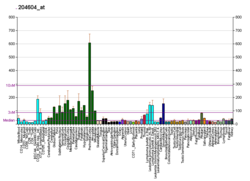Protein-coding gene in the species Homo sapiens
Serine/threonine-protein kinase PFTAIRE-1 is an enzyme that in humans is encoded by the CDK14 gene.[5][6][7]
PFTK1 has been shown to interact with SEPT8.[8]
- ^ a b c GRCh38: Ensembl release 89: ENSG00000058091 – Ensembl, May 2017
- ^ a b c GRCm38: Ensembl release 89: ENSMUSG00000028926 – Ensembl, May 2017
- ^ "Human PubMed Reference:". National Center for Biotechnology Information, U.S. National Library of Medicine.
- ^ "Mouse PubMed Reference:". National Center for Biotechnology Information, U.S. National Library of Medicine.
- ^ Lazzaro MA, Albert PR, Julien JP (Jul 1997). "A novel cdc2-related protein kinase expressed in the nervous system". J Neurochem. 69 (1): 348–64. doi:10.1046/j.1471-4159.1997.69010348.x. PMID 9202329. S2CID 41686721.
- ^ Yang T, Chen JY (Apr 2001). "Identification and cellular localization of human PFTAIRE1". Gene. 267 (2): 165–72. doi:10.1016/S0378-1119(01)00391-2. PMID 11313143.
- ^ "Entrez Gene: PFTK1 PFTAIRE protein kinase 1".
- ^ Yang, Tao; Gao Yan-Kun; Chen Jiang-Ye (Jul 2002). "KIAA0202, a human septin family member, interacting with hPFTAIRE1". Sheng Wu Hua Xue Yu Sheng Wu Wu Li Xue Bao. 34 (4). China: 520–5. ISSN 0582-9879. PMID 12098780.
- Nagase T, Ishikawa K, Suyama M, et al. (1999). "Prediction of the coding sequences of unidentified human genes. XII. The complete sequences of 100 new cDNA clones from brain which code for large proteins in vitro". DNA Res. 5 (6): 355–64. doi:10.1093/dnares/5.6.355. PMID 10048485.
- Yang T, Gao YK, Chen JY (2002). "KIAA0202, a human septin family member, interacting with hPFTAIRE1". Sheng Wu Hua Xue Yu Sheng Wu Wu Li Xue Bao. 34 (4): 520–5. PMID 12098780.
- Scherer SW, Cheung J, MacDonald JR, et al. (2003). "Human chromosome 7: DNA sequence and biology". Science. 300 (5620): 767–72. Bibcode:2003Sci...300..767S. doi:10.1126/science.1083423. PMC 2882961. PMID 12690205.
- Hillier LW, Fulton RS, Fulton LA, et al. (2003). "The DNA sequence of human chromosome 7". Nature. 424 (6945): 157–64. Bibcode:2003Natur.424..157H. doi:10.1038/nature01782. PMID 12853948.
- Barrios-Rodiles M, Brown KR, Ozdamar B, et al. (2005). "High-throughput mapping of a dynamic signaling network in mammalian cells". Science. 307 (5715): 1621–5. Bibcode:2005Sci...307.1621B. doi:10.1126/science.1105776. PMID 15761153. S2CID 39457788.
- Gao Y, Jiang M, Yang T, et al. (2006). "A Cdc2-related protein kinase hPFTAIRE1 from human brain interacting with 14-3-3 proteins". Cell Res. 16 (6): 539–47. doi:10.1038/sj.cr.7310071. PMID 16775625.
- Ewing RM, Chu P, Elisma F, et al. (2007). "Large-scale mapping of human protein-protein interactions by mass spectrometry". Mol. Syst. Biol. 3 (1) 89. doi:10.1038/msb4100134. PMC 1847948. PMID 17353931.
- Shu F, Lv S, Qin Y, et al. (2007). "Functional characterization of human PFTK1 as a cyclin-dependent kinase". Proc. Natl. Acad. Sci. U.S.A. 104 (22): 9248–53. Bibcode:2007PNAS..104.9248S. doi:10.1073/pnas.0703327104. PMC 1890480. PMID 17517622.
- Denoeud F, Kapranov P, Ucla C, et al. (2007). "Prominent use of distal 5' transcription start sites and discovery of a large number of additional exons in ENCODE regions". Genome Res. 17 (6): 746–59. doi:10.1101/gr.5660607. PMC 1891335. PMID 17567994.
|
|---|
| Activity | |
|---|
| Regulation | |
|---|
| Classification | |
|---|
| Kinetics | |
|---|
| Types | |
|---|





